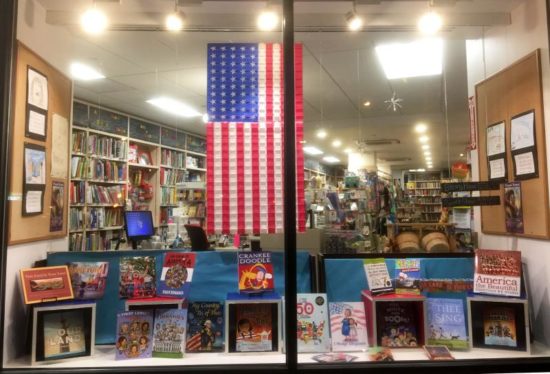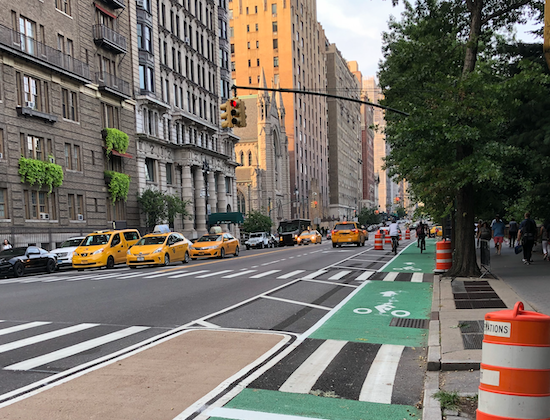By Lucas Brady Woods
The city released the first details of its public school reopening plan on Wednesday, and made it clear that most students will get a mix of remote and in-person learning. The plans provide a basic framework that still leaves enormous gaps for children on the Upper West Side, depending on their background, special needs and the work schedules of the parents.
Mayor Bill de Blasio and New York City Schools Chancellor Richard Carranza announced that schools will use a mix of in-person and remote learning in the fall, with in-person attendance for most students limited to two or three days per week in order to accommodate social distancing. According to de Blasio, the situation will vary depending on each school’s needs and capabilities, with specific plans to be determined this month by school principals, who will let parents know in August which days their children can report to school. He says any parent will be able to choose fully remote learning for their children if they prefer.
De Blasio also says that the extent of school reopening depends on the city’s continued progress in fighting the coronavirus, and that the plan will be adjusted in accordance with public health officials and data.
“Everything we do will be with a very high bar in regard to health and safety,” the mayor said this morning. “We’re gonna put every precaution in place, test to make sure they’re working, and as we’ve said many times, things can change along the way.”
The New York City Department of Education updated the plan on its website today as well. The department’s website says the DOE is investing in technology and updating its curriculum in order to support blended learning, which means a mix of in-person and remote learning, as the mayor announced. The DOE also echoes de Blasio by saying any family can opt into fully remote learning if they choose, but that the majority of families want as much in-person learning as possible.
“Make no mistake,” the DOE says on its website. “New York City students will still be learning 5 days a week.”
But with only about two months left until school starts, Upper West Side parents say they have numerous concerns about the upcoming academic year and no guidance so far on how they should begin to address them.
The parents who spoke to West Side Rag expressed concerns that vary depending on the particular needs of their child and family. Marlene Hidalgo is the coordinator at Bloomingdale Family Center’s Parent Leadership Program, a group that advocates for low-income parents. She also has two daughters in elementary school.
She says the pandemic has exacerbated inequities that already exist between schools that serve different communities. She’s concerned that low income students and students of color will fall disproportionately behind their peers as a result.
Hidalgo says schools’ resources differ greatly from school to school, and that the quality of remote learning depends on a school’s resources. Her youngest daughter, Devina, just finished kindergarten at PS 75 on 96th Street and West End Avenue. Her nephew also just finished kindergarten, but at PS 165, only about 12 blocks away. According to Hidalgo, while her daughter received a tablet stocked with apps to help her learn remotely, her nephew received a pre-recorded Youtube video and a few printouts.
“For kids who are behind, it’s like they’re not being taught,” she says. “You can send a kid a worksheet of this new material, but if they don’t know how to do it, and the parents aren’t home, how are they going to learn it?”
Childcare is especially a concern for many low-income families. Hidalgo says working parents often can’t afford to take time off, nor can they afford childcare, which often leaves their children lacking the supervision and discipline needed to benefit from remote learning. That, she says, will also contribute to them falling further and further behind.
There’s also a concern among parents that students with disabilities will be disadvantaged as plans solidify for the fall academic year.
Natasha Price is a special needs advocate based on the Upper West Side. Her son, Mason, has a developmental disability that requires additional therapy and supportive services to be included in his education. Many of those services are mandated by the Department of Education, through the Individualized Education Program. The process for creating an IEP includes a meeting between the student, their parent and educators, mental health professionals and city officials in order to determine the child’s educational needs, according to the Department of Education website.
Since Mason is entering the 6th grade and starting at a new school, he needed to be reevaluated for his IEP. But Price says when the pandemic closed the courts, it created a backlog in the schedule of IEP hearings which has in turn delayed services for Mason and other students. She says Mason has already missed four weeks of the classes that would have been mandated by his IEP because of the delay in his hearing.
According to Price, the in-person aspect of school is very important for special needs kids and she’s worried they will fall through the cracks if the new academic year includes a lot of remote learning. She says she’s already received calls about some special needs students regressing.
“The main concern I have is the continuation of services,” she says, “Academics are very important. But socialization is the most important, and you can’t do that remotely.”
Another parent, Kari Docter, has two kids, one in middle school and the other in elementary school. Docter and her husband are both musicians at the Metropolitan Opera and live on the Upper West Side. Both have also been furloughed as a result of the pandemic and have relocated temporarily to Minnesota where her parents live.
She says one of her concerns is being able to afford living in Manhattan now that neither she nor her husband are working. She’s considering making the relocation permanent.
“We don’t know when we’re going back to work,” she said. “How do we manage a family being in New York City? What are we gonna do, move into my parents basement?”
But Docter says she considers herself lucky to even have the option of leaving the city. At the end of the day, she says she’s most concerned about the obstacles presented by the pandemic that are facing low-income families, families who may have no choice but to stay put and keep working.
Marlene Hidalgo, for one, has hopes for a silver lining. She says that the pandemic is shining a bright light on inequities in education, and that maybe, when it’s over, society will be more willing and able to fix them.









I am usually not a fan of the mayor but in this case, I don’t know if there is a better solution. This situation is just an absolute mess. I am glad that they are trying to provide an in-person option for those who want it. I think it is critical to have some face-to-face time, particularly for younger children. Ideally they could hire many more teachers to accommodate smaller classes, but the money is not there.
I do not know how parents will manage through this – it will be incredibly difficult, particularly for those who cannot work remotely. I struggle to see what the end game to all of this will be.
Perhaps Significantly improve curricula and make teachers actually teach? What the pandemic has done is stress test the schools. Teleschool is tough on all but classes with curricula did miles better I observed personally and even in a new medium could immediately spot the better teachers confirming in real time what I had suspected. Many private schools did far better teleschooling (No one does great teleschooling but far better) not because their kids are magically into teleschool but because they have good curricula and creativity, made the teachers teach remotely, and did not tolerate union “Not gonna work” entitlement, and had parental backup to enforce schoolwork get done. Covid has exposed how lacking many public school curricula are and the deficits short sighted union policies wreak on our kids. No good solutions to teleschcool but improvements possible that will also reverberate when back to physical school.
I am all for paying teachers to participate in extensive training seminars that will improve their online curricula, since teaching online is a very different skillset from teaching face-to-face.
Cuomo is smart, tough, seasoned and DeBlasio/Carranza are not.
Schools reopen, when? That’s the unknown right now.
Absolutely not safe to have our children indoors. Using the rest rooms. No. Just no because there is risk. Who is willing to take any risk with their children. The inflammatory syndrome is serious. And what happens if while they are back in school there is a new surge?
So — ?
Do you suggest we keep our kids away from school until there’s a vaccine, or until
the virus is gone, forever?
They may end up graduating high school
at age 24.
If you volunteer your your kids being a guinea pigs to see how it would affect community, by all means.
Not my kids.
A long time ago a much younger and hotter headed me quit a job because my desk was within earshot of a men’s room. There’s no way my child will go to school where there’s even a glimmer of chance that she’ll sit in the restroom. Remote learning is good enough. I’ll tutor her myself if need be.
Will parents agree not to sue city of their kids get COVID?
I’m sure they will make sign the voucher – then they will not.
You have to assume state tests are going to be cancelled again for the upcoming school year. No need to administer a test to tell us what we all know, that the kids aren’t going to be up to grade level
Or they’ll simply lower the bar – yet again – and celebrate our kids “passing” despite not being able to make it through the old test. They’ll call it a “new & improved grading methodology” or “a more equitable model for grading” or something silly like that. Voila, everyone’s a winner! Except, when everyone’s a winner, the reality is that everyone’s actually a loser. But we don’t need to know that as long as we feel good about ourselves.
I am a public school teacher. Although I miss being in a school building and teaching my students – and recognize that remote learning pales in comparison – there are many unanswered questions…
How to keep students, teachers, other staff and receptive families safe indoors:
-Poor ventilation – many school buildings do not have HVAC systems. Even in newer school buildings, like the one I workr in, they can’t even control heating and AC (sometimes it is freezing cold or boiling hot).
-Sanitizing – prior to Covid, the custodians were already complaining that they did not have enough time to mop the floors each day, let alone properly sanitize every classroom, bathroom, hall, etc. I had to buy my own soap, hand sanitizer and disinfectant spray and wipes for my classroom. Prior to school closing, (I had 8 students out sick – each were out for 2+ weeks, but they could not get a covid test.)
-Many staff members take public transportation to work. I’m sure many parents of students will also take public transportation to their respective jobs. Once one person gets infected, it will spread like wildfire in a school.
The only staff exempt from having to go into a school building will be those who can get medical documentation stating such. Staff members live with others who may be immunocompromised are not exempt. Teachers who may have kids at home with compromised immune systems do not have the option to keep their kids at home to do remote learning exclusively bc the parents have to go in to teach.
-Many elementary schools no longer have individual desks; we have tables that are shared amongst 4-6 students and rugs that the children congregate on. Are we getting plexiglass dividers?
-Practically everything in PreK-1st grade is shared in the classroom, from books to pencils to toys. Some of these items can be made to be individualized but things like books and wooden blocks….Is the expectation that these items be sanitized prior to another child touching them?
-It is not feasible to expect the youngest children (PreK-1st grade) to keep their masks on and to socially distance. It is hard enough for grown adults to wear their masks walking on the street.
-So much of early childhood learning is about engaging with others, playing together, working in partnerships and in groups, learning how to read people’s emotional, etc. How do we continue to go about educating in this way with social distancing and mask wearing?
-If teachers are working in school buildings 5 days a week and prepping for that, who will be doing the remote learning portion? It is not feasible for one teacher to do both.
-Childcare will be a disaster! Families will have to find childcare for the days their child is not assigned to be in (with, hopefully, a childcare provider that will continue to have the child engage in remote learning on those days). Where will the children of teachers go on those days? The teacher cannot just stay home with their own child bc s/he has to be at work to teach other children!
The children that suffer the most and that need the most through this pandemic are the low income, no income, and/or immigrant students and students with special needs.
There are no answers from the DOE on how to address any of these issues.
100 words – remember WSR?
Actually a little misquoted but that’s ok as it still sheds light on the problems special needs children are facing, I was grateful my son had his IEP meeting prior to the pandemic but many parents are struggling with delays and not having them in person, impartial hearings are delayed as we are short court officers. I am truly worried about the masks for children who need to read lips, have auditory processing and have trouble self regulating. We missed four weeks of services due to pandemic and not having services in place for continuation as many other children experienced as well.thank you for writing this. September is going to be a mess for us all.
That is tough. I guess the solution is what a lot of parents had to do before school – home or office visits.
This will further exacerbate inequality which is sad. I feel for all parents trying to make child care work. Not a lot of great options here.
thanks to teacher Jamie and parent Natasha, both above, for an intelligent and informative discussion of many of the issues.
I get that many people are unhappy with the plan. But what are the alternatives. Remote only? Not effective for many students, poor internet access, parents home the whole time not going to work, or kids left hone alone?
Fully on site? Unsafe for students, families,teachers staff.
No one is going to throw billions of dollars at school systems nationwide, so trying this approach may be as good as it can get, realistically.
I don’t like it, but what is the best of of all bad choices?
How is this the best option? It helps no one, teachers will still be exposed to 100% of students in a weeks time and parents are looking at having to take a hit to the household income to have a parent at home full time to help teach and watch their children? Daycares have been open to first responders since March and it hasn’t caused any kind of localized spike in children attending or daycare workers. Children have been largely unaffected and no evidence worldwide has identified them as potent vectors. No one is outraged about daycares reopening, why are schools being treated as the golden exception?
One of the problems with remote learning for public schools is that it does not work well for groups of 25 kids- the city would have to hire more teachers and teach the lessons in smaller groups to be effective.
Another alternative to 2-3 days a week of learning in a classroom would be to have a morning and an afternoon session. Half the kids would attend in the morning and the other half in the afternoon. This option would require hiring more teachers too unless they agreed to teach two sessions in one day.
Whether teaching remotely or in person, the city will have to spend more money on teachers, and will just have to put out a bond to finance the extra expense. If they can pay for the police, they can find money for teaching kids during a long emergency period.
Not sure if people realize that Carranza makes over $350,000 per year and our mayor makes over $250,000 per year. This is public knowledge so you can look it up any time on OpenData NY. I was shocked when I learned this. Making $500,000 a year between them and the school system is like this and is as unprepared as this?
We can do better. I ask everyone to think hard the next elections over the new few years. Our entire elected city government are failing us.
Carranza-$350k a year? Who gave him this money.? I’m not asking for what.
Regarding child care – what did we all do pre-school? Day cares and nannies and they were not cheap. I was glad when I could start parting for only half-day of child care. Right now I guess we are back to where we were. Better than sickness and death.
What is the difference between daycare and school in terms of protecting children from the virus? If kids can be sent to daycare what the reasoning they cannot be sent to school? The American Academy of Pediatrics is recommending children go back in person to school, but apparently now the CDC is the only health guidelines anyone wants to follow when it comes to children returning to school.
I meant extra funds for child care. Nannies, obviously. Please read and process before jumping anyone’s throat.
I read, you specifically wrote day care and nannies. There’s no jumping on anyone just legitimate questions about how daycare is different than school, and why it would be ok to send kids to daycare but not school.
i Meant FUNDS for the child care! God forbid I mentioned that some parents used such funds for day care as well as nannies.
It is tough but all parents did it and had their job.
Will you stop changing the subject in the direction you want. Start your own thread if you want and stop nitpicking.